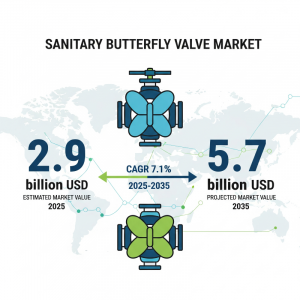Sanitary Butterfly Valve Market Set for Robust Growth: A Surge in Demand for Hygienic Fluid Control Solutions.
Growing demand in food, beverage, & pharmaceutical industries fuels the expansion of the Sanitary Butterfly Valve Market with a focus on hygiene and automation.
NEWARK, DE, UNITED STATES, August 7, 2025 /EINPresswire.com/ -- The Sanitary Butterfly Valve Market is poised for exceptional growth, with projections indicating an increase from USD 2.9 billion in 2025 to USD 5.7 billion by 2035, representing a compound annual growth rate (CAGR) of 7.1%. This surge in demand reflects the critical role that sanitary valve technologies play in industries such as food, beverage, and pharmaceuticals, where hygiene, reliability, and automation are of paramount importance.
As global industries face mounting pressure to adhere to stringent hygiene and contamination prevention standards, the need for advanced sanitary valves that offer superior performance, ease of maintenance, and reliable operation has never been greater. Sanitary butterfly valves—known for their simple construction and effective fluid control—are becoming indispensable in various manufacturing sectors.
Key Growth Drivers in the Sanitary Butterfly Valve Market
The expansion of the Sanitary Butterfly Valve Market is largely driven by the growing demand for hygienic fluid control solutions. Industries like food, beverage, dairy, and pharmaceutical manufacturing are under constant scrutiny to meet increasingly stringent hygiene standards, especially with heightened regulations around contamination prevention.
One of the major drivers of growth is the rising automation of manufacturing processes. As production lines become more sophisticated, the need for pneumatic butterfly valves, which offer fast, precise, and automated control, has increased significantly. By integrating these valves into automated systems, companies are able to achieve greater process efficiency and minimize human intervention, reducing the risk of contamination and enhancing productivity.
Furthermore, the global push for food safety compliance and improved quality control in manufacturing has led to a significant increase in infrastructure investments, particularly in food and beverage processing plants. These investments are helping drive demand for valves that can withstand harsh cleaning agents, handle high-pressure systems, and ensure the highest standards of hygiene in processing lines.
Market Segmentation and Key Insights
The Sanitary Butterfly Valve Market is divided into several segments, each playing a vital role in the market's rapid growth.
• Valve Type: The pneumatic butterfly valve segment leads the market, with a projected market share of 39.2% in 2025. The adoption of these valves is largely driven by their automation compatibility, which allows for enhanced flow control and remote operation, making them indispensable in automated production systems in food and pharmaceutical manufacturing.
• Material: Stainless steel is the dominant material used for sanitary butterfly valves, projected to account for 46.7% of the market share by 2025. Stainless steel valves are favored for their corrosion resistance, durability, and hygienic properties, which ensure contamination-free fluid flow and facilitate compliance with stringent sanitary standards.
• Size: The medium-sized valves (ranging from 2–6 inches) are set to lead the market with 43.5% of the revenue in 2025. These valves offer an optimal balance between flow capacity and compact installation, making them ideal for a variety of industries, including dairy, beverages, and pharmaceuticals.
• End Use: The food and beverage sector continues to dominate the end-use application for sanitary butterfly valves. As demand for contamination-free, automated production grows, industries are relying more on these advanced valve systems to improve efficiency and maintain the highest standards of hygiene.
Growth Opportunities in Key Regions
The global market's growth trajectory is not only strong in developed markets but also in emerging regions. Key regions witnessing strong growth include:
• Asia-Pacific: The market in Asia-Pacific, driven by China and India, is growing rapidly due to the expanding dairy and food industries. China is projected to lead the region with a CAGR of 9.6%, driven by increased demand in food processing and biopharmaceuticals. India follows with a CAGR of 8.9%, bolstered by government-backed initiatives and the rapid expansion of dairy processing facilities.
• North America and Europe: North America and Europe are witnessing continued demand due to high regulatory standards for food safety and the rapid adoption of automated systems in food and pharmaceutical plants. These regions focus on automated valve solutions to comply with stringent FDA and EHEDG standards.
Trends Shaping the Future of Sanitary Butterfly Valves
Several trends are driving innovation and adoption in the sanitary butterfly valve market:
• Automation and Digital Integration: The increasing integration of pneumatic actuators and digital connectivity in valves is enhancing performance and ease of maintenance. Smart valves equipped with IoT sensors and predictive maintenance features are becoming increasingly popular in industries that demand continuous monitoring and system optimization.
• Compact Valve Designs: The demand for compact, lightweight valves is growing as manufacturers seek efficient and cost-effective solutions for automated production systems. These valves are increasingly being integrated into modular skid units and clean-in-place (CIP) systems, offering quick installation and minimal downtime.
• High-Performance Alloys: In pharmaceutical and biopharmaceutical applications, manufacturers are adopting high-performance alloys and advanced sealing materials to withstand aggressive cleaning agents and ensure product integrity.
Challenges in the Sanitary Butterfly Valve Market
Despite strong growth prospects, the sanitary butterfly valve market faces a few challenges:
• Material Price Volatility: The fluctuating costs of stainless steel and other alloys can impact production costs and affect the price stability of valves. This can hinder adoption in smaller markets and facilities with limited budgets.
• Compliance Delays: Stringent certification requirements for industries like food processing and pharmaceuticals can cause delays in valve procurement and implementation, limiting adoption in smaller-scale operations and emerging markets.
• Complexity of Regulatory Standards: Adhering to various regulatory standards—such as FDA, EHEDG, and 3A—can be complex and time-consuming, especially in markets with rapidly changing regulations
Discover key market opportunities – Request your sample report now!
https://www.futuremarketinsights.com/reports/sample/rep-gb-22876
For more on their methodology and market coverage, visit
https://www.futuremarketinsights.com/about-us
Explore Related Insights
Floriculture Market:
https://www.futuremarketinsights.com/reports/floriculture-market
Car Air Freshener Market:
https://www.futuremarketinsights.com/reports/car-air-freshener-market
Flooring Market:
https://www.futuremarketinsights.com/reports/flooring-market
Metal Furniture Market:
https://www.futuremarketinsights.com/reports/metal-furniture-market
Wood Based Panel Market:
https://www.futuremarketinsights.com/reports/wood-based-panel-market
Editor’s Note:
This press release offers a strategic analysis of the Sanitary Butterfly Valve Market, providing manufacturers with key data on growth projections, material preferences, and geographic opportunities for future expansion.
Rahul Singh
Future Market Insights Inc.
+1 347-918-3531
email us here
Legal Disclaimer:
EIN Presswire provides this news content "as is" without warranty of any kind. We do not accept any responsibility or liability for the accuracy, content, images, videos, licenses, completeness, legality, or reliability of the information contained in this article. If you have any complaints or copyright issues related to this article, kindly contact the author above.
7-Day-Notary.com Expands Certified Loan Signing Agent Services Across Los Angeles, Orange, and Riverside Counties
Savor the World’s Finest: Kobe Beef Steak Ishida Expands Premium Teppanyaki Dining in Japan’s Top Cities
GPT-OSS-120B & 20B Models Now Available on GPT Proto Platform
Więcej ważnych informacji
 Jedynka Newserii
Jedynka Newserii

 Jedynka Newserii
Jedynka Newserii

Polityka

D. Joński: Nie wiemy, co zrobi Rosja za dwa–trzy lata. Według duńskiego wywiadu może zaatakować kraje nadbałtyckie i musimy być na to gotowi
Zdecydowana większość krajów unijnych wskazuje na potrzebę wzmocnienia zdolności obronnych Europy w obliczu coraz bardziej złożonego geopolitycznego tła. Wywiady zachodnich państw wskazują, że Rosja może rozpocząć konfrontację z NATO jeszcze przed 2030 rokiem. Biała księga w sprawie obronności europejskiej „Gotowość 2030” zakłada m.in. ochronę granic lądowych, powietrznych i morskich UE, a sztandarowym projektem ma być Tarcza Wschód. – W budzeniu Europy duże zasługi ma polska prezydencja – ocenia europoseł Dariusz Joński.
Transport
Duże magazyny energii przyspieszą rozwój transportu niskoemisyjnego w Europie. Przyszłością może być wodór służący jako paliwo i nośnik energii

Zmiany w europejskim transporcie przyspieszają. Trendem jest elektromobilność, zwłaszcza w ramach logistyki „ostatniej mili”. Jednocześnie jednak udział samochodów w pełni elektrycznych w polskich firmach spadł z 18 do 12 proc., co wpisuje się w szerszy europejski trend spowolnienia elektromobilności. Główne bariery to ograniczona liczba publicznych stacji ładowania, wysoka cena pojazdów i brak dostępu do odpowiedniej infrastruktury. – Potrzebne są odpowiednio duże magazyny taniej energii. Przyszłością przede wszystkim jest wodór – ocenia Andrzej Gemra z Renault Group.
Infrastruktura
W Polsce w obiektach zabytkowych wciąż brakuje nowoczesnych rozwiązań przeciwpożarowych. Potrzebna jest większa elastyczność w stosowaniu przepisów

Pogodzenie interesów konserwatorów, projektantów, inwestorów, rzeczoznawców i służby ochrony pożarowej stanowi jedno z największych wyzwań w zakresie ochrony przeciwpożarowej obiektów konserwatorskich. Pożary zabytków takich jak m.in. katedra Notre-Dame w Paryżu przyczyniają się do wprowadzania nowatorskich rozwiązań technicznych w zakresie ochrony przeciwpożarowej. W Polsce obowiązuje już konieczność instalacji systemów detekcji. Inwestorzy często jednak rezygnują z realizacji projektów dotyczących obiektów zabytkowych z uwagi na zmieniające się i coraz bardziej restrykcyjne przepisy czy też względy ekonomiczne.
Partner serwisu
Szkolenia

Akademia Newserii
Akademia Newserii to projekt, w ramach którego najlepsi polscy dziennikarze biznesowi, giełdowi oraz lifestylowi, a także szkoleniowcy z wieloletnim doświadczeniem dzielą się swoją wiedzą nt. pracy z mediami.




![Nestlé w Polsce podsumowuje wpływ na krajową gospodarkę. Firma wygenerowała 0,6 proc. polskiego PKB [DEPESZA]](https://www.newseria.pl/files/1097841585/fabryka-nesquik_1,w_85,r_png,_small.png)




.gif)

 |
| |
| |
|